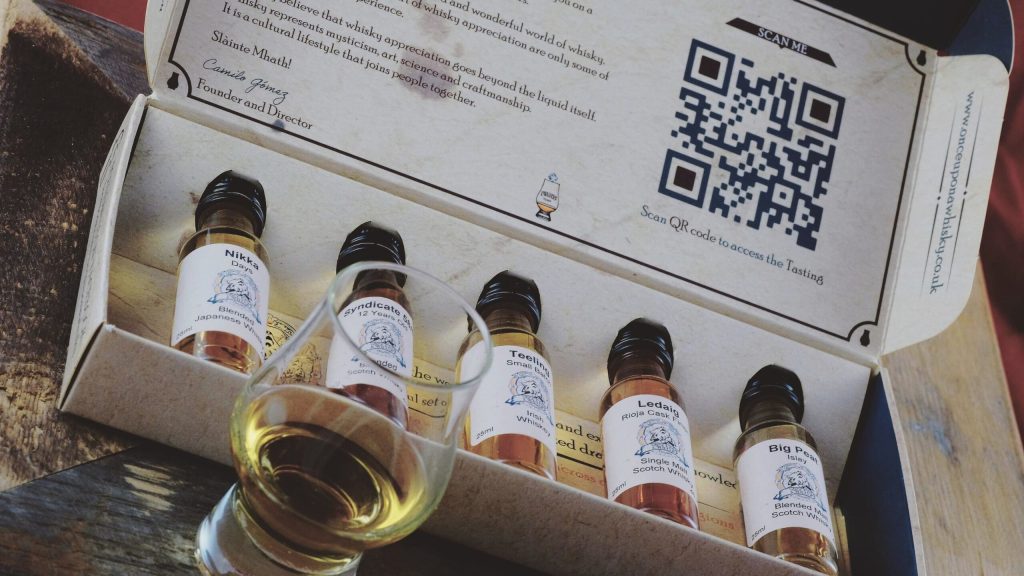Whisky Experience at Home with Once Upon a Whisky

Welcome on board! At Once Upon A Whisky, we are passionate about sharing the stories behind the water of life, especially those that fascinated us the most.
This is why we have launched a collection of exclusive tasting sets.
Come with us on a fascinating whisky journey around the world, where you can try some of our favourite whiskies and learn about their stories.
But now, let’s dive inside the box! Whether you have ordered one of our tasting packs or are considering getting one, we want to share some of the stories behind the drams we selected for you.
Enjoy the journey!
Nikka Days – Blended Japanese Whisky
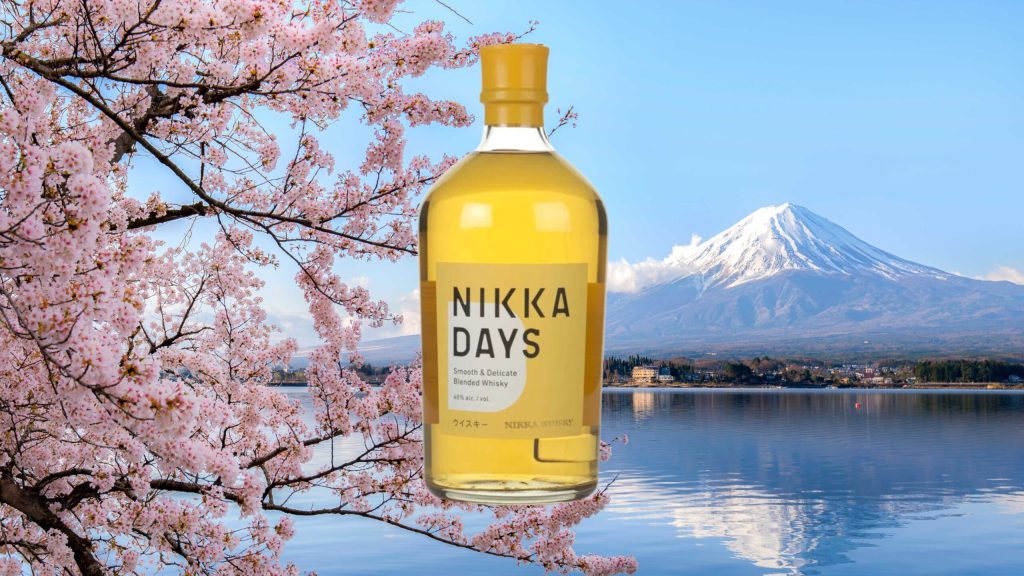
The history of Japanese whisky is strongly intertwined with Nikka, which operates the Yoichi distillery in Hokkaido and the Miyagikyo distillery in Sendai, contributing to the Nikka Days blend.
Nikka was founded 1934 by Masataka Taketsuro, a chemist who travelled to Scotland to learn the art of distilling whisky in his youth. He studied organic chemistry at the University of Glasgow, where he met his future wife, Jessie Roberta “Rita” Cowan (Japanese TV channel NHK also broadcasted a drama series based on their love story, called Massan). He gained valuable hands-on experience working for several years distilling at Hazelburn in Campbeltown, eventually returning to Japan, bringing back his knowledge and igniting the whisky distilling movement.
After working with Shinjiro Torii, the other man behind Japanese whisky and the founder of the company we know today as Suntory, he decided to go solo when the two fell apart. He moved to Yoichi (an area full of peat, good agricultural land, and abundant water) and established what became Nikka, which is now one of the most well-known brands of Japanese whisky.
In the following decades, the reputation of Japanese whisky grew stronger and boomed in the mid-80s, and the country is now one of the strongest players worldwide in whisky production.
At a production level, Scotch has similarities as this is where the main inspiration came from.
However, its unique cultural background and the demand for fast-paced production have shaped the industry and developed a specific character.
For instance, each distillery has to rely on its production as, unlike in Scotland, Japanese companies don’t trade in stock among each other. Because of this, distilleries in Japan are a chameleonic breed, and each one is equipped to produce a wide range of styles, from grains to malt, smoky to unpeated, using a variety of fermentation and distillation techniques.
Whisky produced in Japan is known for being relatively clear and light in character (with obvious exceptions, Yoichi being among these with its smokier and oily spirit).
The Whisky
Nikka Days is a blended whisky (whisky made with a variety of malt and grain whiskies from different distilleries blended together) that features spirits distilled in Coffey stills at Miyagikyo distillery, single malt from the same distillery and Yoichi, and Coffey malt (a spirit made using malted barley but distilled in a continuous still).
It’s a lovely, easy-drinking dram that goes well neat or in a mizuwari, the traditional Japanese highball consisting of whisky and sparkling water on ice.
Teeling Small Batch – Irish Whiskey
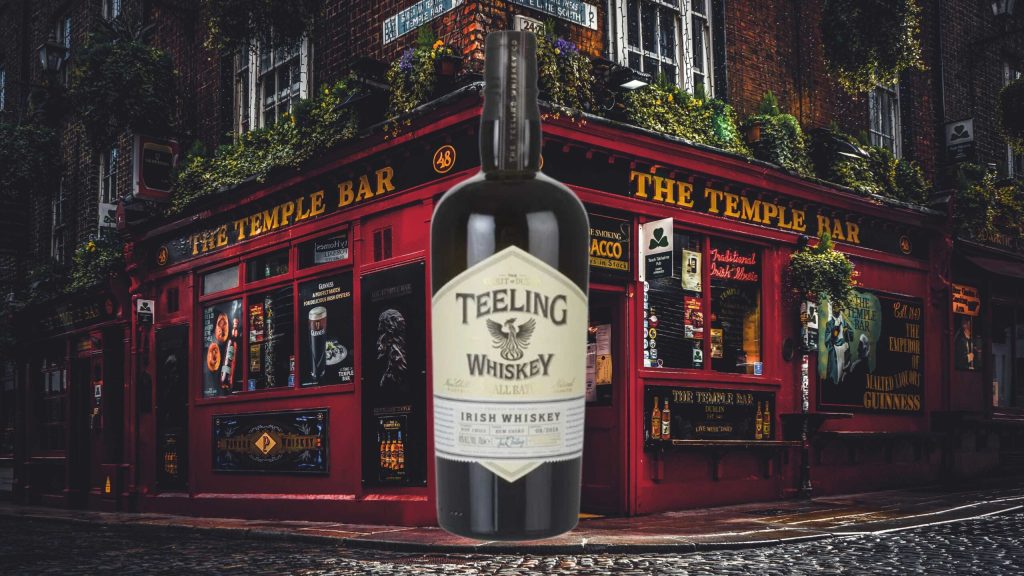
Our second dram of the day hails from the Emerald Isle, a distillery at the forefront of the renaissance of Irish whisky in recent decades.
Teeling Distillery’s symbol is a Phoenix, representing the rebirth of the Dublin distilling tradition.
If you want to know more about Irish whiskey, we recently published a special St Patrick’s Day blog.
To paint the picture: despite a dispute with Scotland on where whisky was born, the known written records place the pin as the cradle of whisk(e)y-making in Ireland.
Scotch and Irish Whiskey have had a particular rivalry throughout the years. The Irish Spirit, generally triple distilled, was a more palatable product than the harsher single malts Scotland produced in the past. The USA was a significant market for Irish whiskey.
However, there was a steep turn of favour in the 19th Century: Ireland suffered during and after the First World War and their War of Independence, culminating in establishing an Irish Free State in 1922. At the same time, Scottish producers started investing in blended whisky, whose smoother character made it a much-preferred tipple around the world and the advent of Prohibition cut off one of the most important markets for Irish whisky.
Only two malt whiskey distilleries remained operative after this: Old Bushmills in Northern Ireland and Midleton Distillery.
The late 80s saw a resurgence of the Irish whiskey industry, starting from the opening of Cooley Distillery in 1987 (in a building formerly used to convert potatoes into industrial ethanol and produce the spirit for Bailey’s Irish Cream Liqueur).
And here is when Teeling comes in as we know it today. The family had already been tied to the industry since 1782, when Walter Teeling established a distillery in the Liberties district of Dublin. His descendant, John Teeling, was the mind behind the founding of Cooley Distillery. Cooley was sold in 2011, and then two Teeling brothers, John and Stephen, operated as an Independent bottling company first and then founded the new Teeling Distillery in 2015 in the heart of Dublin (well worth a visit!).
Teeling draws from the tradition of Irish distilling (with expressions such as their Single Pot Still ones) and, at the same time, experiments with new flavours, casks, and techniques.
The Whisky
The Small Batch Irish whiskey is made with a blend of malt and grain whiskeys, initially aged in ex-Bourbon barrels. It’s then finished in Central American Rum casks to give it a tropical, sweet note.
Syndicate 58/6 – Blended Scotch Whisky
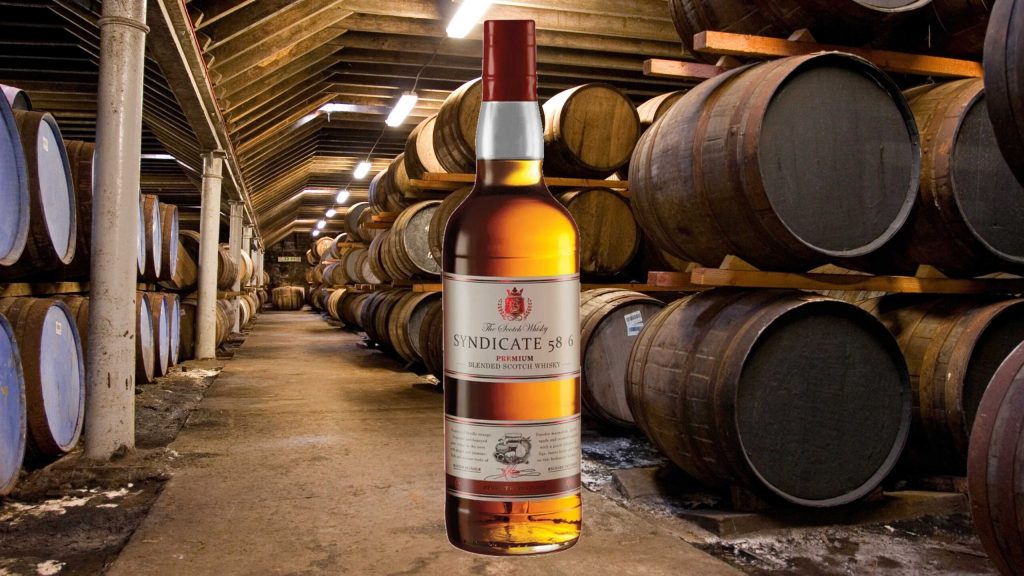
We mentioned earlier how the whisky industry in Scotland soared after investing in blended whiskies. This became possible after the invention of the continuous still in the 1830s, which allowed for more efficient spirit production and, by using different grains, delivered a smooth whisky base to which colour and taste were added by a palette of single malts that contributed to the flavours.
Independent bottlers like Douglas Laing, the company that developed Syndicate 58/6, play an exciting role in whisky’s success.
Independent Bottlers…
They are third parties who buy the whisky and casks directly from the distilleries. They might find exceptional casks they want to release, try different finishes and maturations, and blend some whiskies they get together. They allow us to try flavour profiles that are very different from the ones distilleries have to stick to for consistency.
Douglas Laing & Co. was established in 1948 by Fred Douglas Laing and is now run by his grandson and granddaughters, Fred Laing and Cara Laing. Stewart Laing, another brother, founded his own company, Hunter Laing & Co.
The company is well known for its Remarkable Regional Malts brand, a selection of blended malt whiskies which aim to showcase the spirit of each one of the whisky regions, among which feature The Epicurean, Scallywag, and, as we will taste later, Big Peat.
The Whisky
The story of Syndicate 58/6 is very fascinating, and its latest recipe has the signature of the celebrated master blender Richard Paterson.
In 1958, a rare blend of Scotch malt and grain whiskies was found in 10 casks in a warehouse in Port of Leith, which William Muir Bond 9 Ltd owned. The blend had been distilled in 1954 and made into a recipe that dated back to the 1800s. The directors at William Muir Bond 9 Ltd and a close group of friends (6 in total, hence the whisky name) waited until 1966 when the whisky clocked its 12th year and was bottled. Containing 18 different single malts and 4 grains, maturation was done using the Solera system; I spent time in Oloroso Sherry cask as a finish last year. A true delicacy!
Insight: The Solera System
Sherry is a fortified wine whose casks are very popularly used for maturing whisky. Depending on the type of sherry used, this will impact the flavour of the whisky, adding spicy, sweet, fruity notes or more nutty, dry hints.
But, back to the solera system: this is the warehousing system used for sherry casks. These are arranged in different tiers (criaderas), with wine of the same age contained at each level. The youngest wine from the latest harvest will be placed on top, and the oldest one (called solera), ready to be bottled, is placed at the bottom. When part of the wine is taken from the solera, it is replaced with wine from the upper level, which is the second oldest – and the younger wine will replace this part of the wine, effectively blending different wines of different ages. This process allows the winemaker to obtain a consistent product at each batch.
(The website sherrynotes.com offers an excellent and in-depth description of the Solera system, should you wish to learn more).
So, we finally got to the peaty side of our tasting pack!
Before we hit it with our first smoky delicacies, let us spend a few words on what peat is and how it works in whisky.
What is Peat?
Peat, or turf, is created by decomposing wetland vegetation such as roots, moss and heather in a constantly waterlogged environment. The scarcity of oxygen underwater leads to partial, slow decomposition of the organic matter, while the upper layers create pressure on the base. This “dead plants” layer builds up in layers and is eventually broken down by microbes. In the summer months, the peat is usually “cut” – extracted and let dry so that it can be turned into combustible – and this is how it enters the whisky-making process.
Peat and Whisky
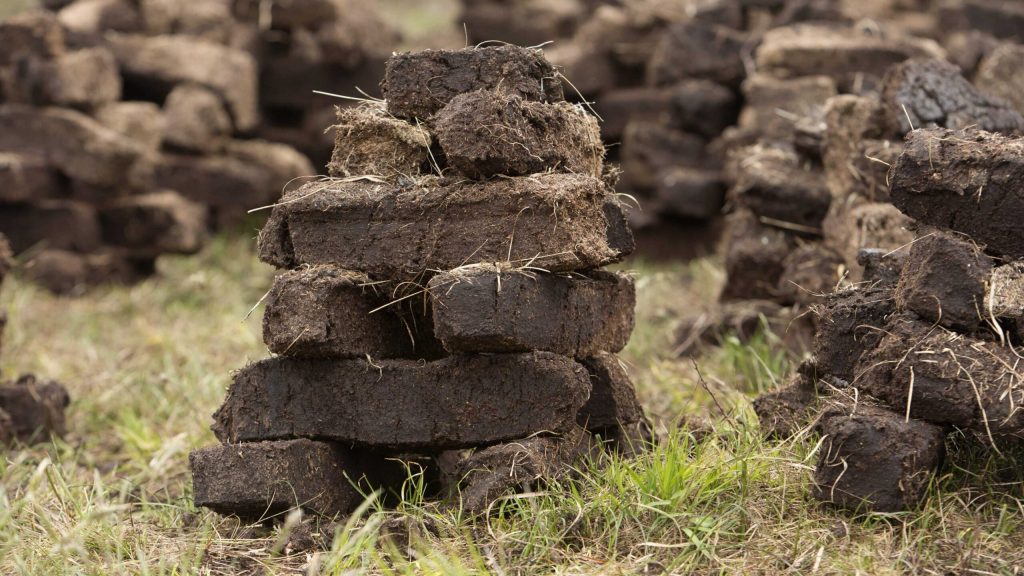
Dried peat is used in the malting process, which means it interacts with the barley used to make the whisky. At this early stage, it contributes to the flavour of a whisky.
Peat is added to the kiln by maltsters and distillers. It is used as a fuel to create hot air, and its fumes dry the barley while giving the grains a smoky flavour. The flavour compounds associated with this particular element, called phenols, will be used to measure ‘how smoky’ the whisky is. If you see PPM related to a whisky, it will mean ‘Parts per Million’ and refer to the phenols present in the barley. Distilleries like Ardbeg and Bruichladdich typically use barley with a reasonably high PPM (50 and more). In contrast, the malt for Ledaig, which we will discover next, is usually peated up to 30 to 40 ppm.
(A very light, smoky hint can also be imparted using casks that previously held smoky whisky, but it will be less powerful and easy to control than peat barley.)
Fun Fact: The Icelandic distillery Eimverk has been using sheep dung to create one of its flagship bottlings, Floki.
Ledaig Rioja Cask Finish
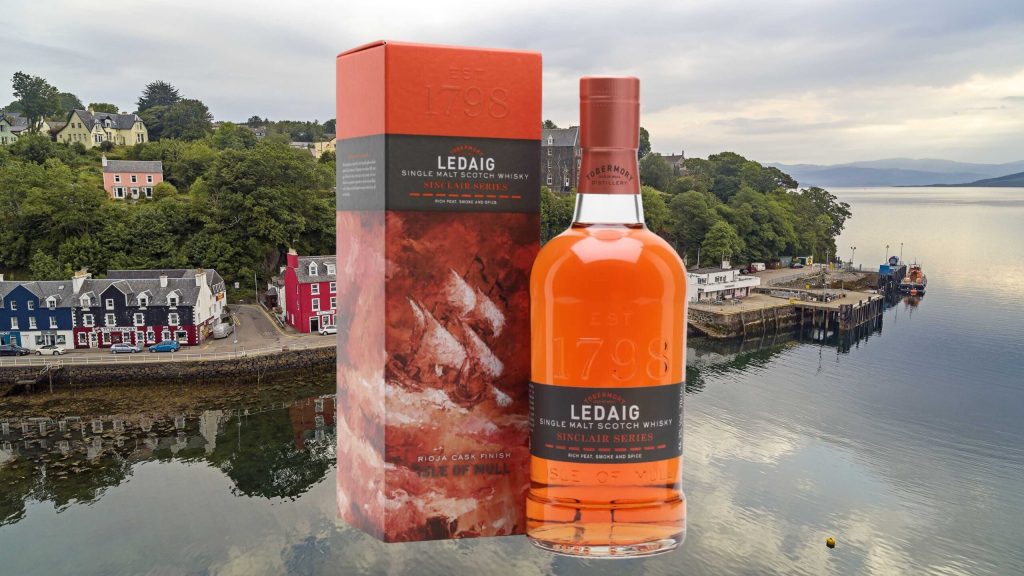
Ledaig (meaning ‘safe-haven‘ in Gaelic and pronounced “Letch-ick”) is the name given to peated whisky from Tobermory, the only distillery on the Isle of Mull.
This beautiful Island on the West Coast of Scotland is a paradise for wildlife and outdoors lovers. Of course, whisky enthusiasts will find something to cheer for.
Located in the Island’s main village, from which it takes the name, Tobermory Distillery is part of this colourful landscape of a northern fishing settlement. Born in 1790, the distillery produces peated and unpeated whisky (under Tobermory), which is used in blends such as Black Bottle and Scottish Leader.
In its history, Tobermory has known several long silent periods, one lasting between 1837 and 1878 and again for four decades after 1930. At different times in history, the distillery was owned by unusual joint ventures, an English company which aimed to turn part of it into holiday accommodation and used part of the premises to store cheese. Burn Stewart, now under the umbrella of South African Distell, acquired the company in 1993 and has since pushed it.
The Whisky
Ledaig Rioja Cask combines all the oily, maritime qualities of a flagship Ledaig with the sweet, spicy notes the Rioja wine finish brings. The distillery’s first expression of the Sinclair Series celebrates Tobermory’s founder, John Sinclair.
The story behind the whisky is that of a Spanish galleon that sank off the harbour of Tobermory over four centuries ago. It was said to hold a secret and rich treasure, now buried in the depths of the village’s shoreline.
Matured in bourbon casks and finished in Spanish Rioja wine casks, the whisky balances the flavours of seaweed, grapes, and berries with a peppery smokiness.
More about Rioja Wine
The wine grown in the province of La Rioja is the oldest in the country to obtain a Designation of Origin, having received one in 1925. Located in North Central Spain, it is mainly known for its red wine production, based around Tempranillo grapes—the region’s wine production benefits from hot summers and cold winters with high rainfall. The wines tend to be significant in flavour and high in tannins.
Big Peat
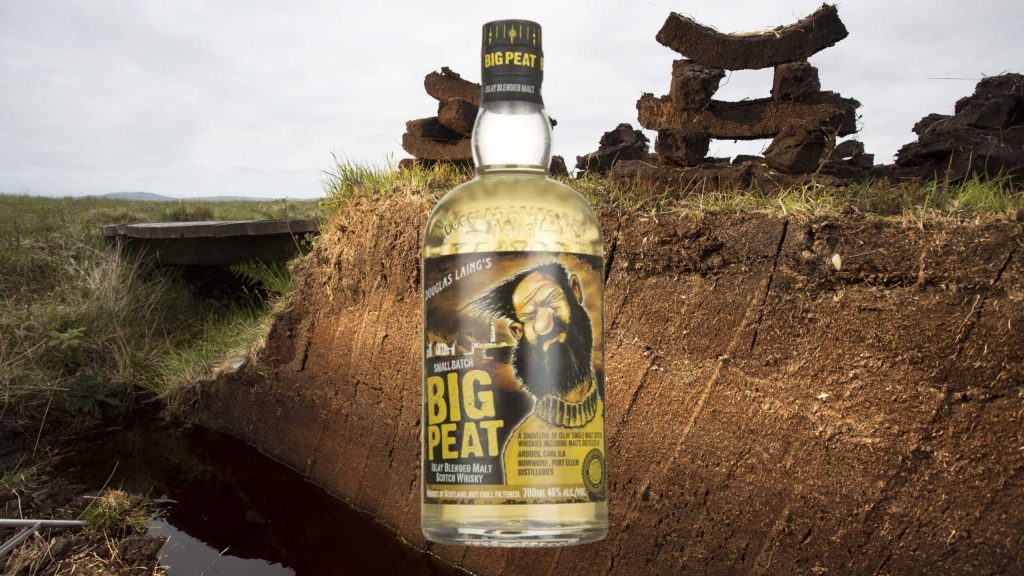
A blended malt (a whisky made by mixing different single malts, but no grain whisky) produced by the same independent bottler behind the Syndicate 58/6, Douglas Laing, Big Peat encapsulates the spirit of the whisky Island by excellence: Islay.
In fact, on an island of just over 600 km², there are nine operating distilleries, with plans for new ones and at least one coming back to life.
Big Peat contains single malts from distilleries that differ in flavour profile and character: Ardbeg, Bowmore, Caol Ila and Port Ellen. Hailing from different points on the Island, their blend offers a fascinating and diverse flavour profile with a dominant and powerful smoky profile.
The whisky is one of the Remarkable Regional Malts range, a series of blended malts aiming to showcase the characteristics of the six whisky regions. If Big Peat represents Islay, Timorous Beastie showcases the Highlands; Scallywag stands in for Speyside, The Epicurean is made with Lowland Malts, Rock Island with malts from the Islands, and The Gauldrons is the Campbeltown expression.
One thing that stands out across the range, particularly in this bottling, is the label, which brings a more modern look to a whisky bottle. The bearded Mascotte, called Ileach (someone who lives in Islay), features all the brand’s bottlings.
An unusual fact is the presence of Port Ellen malt in the blend: the distillery was closed in 1983, and in the past years, stock of this whisky has become very rare. So, this is an exciting addition and a way to understand this part of distilling history in a more affordable context.
The Whisky
The name is a good hint – this dram is very big on peat, made mainly with what would seem relatively younger whiskies to enhance the smoky compounds (which, contrary to what some may think, fade with time in the maturation process). An element of sea breeze and brine makes you think of tasting oysters on the beach next to a bonfire.
Where to buy a Whisky Tasting Set?
You can dive into one of our whisky-tasting experiences by purchasing our exclusive tasting pack here.
We hope you enjoyed the journey with us!
Slainte!

